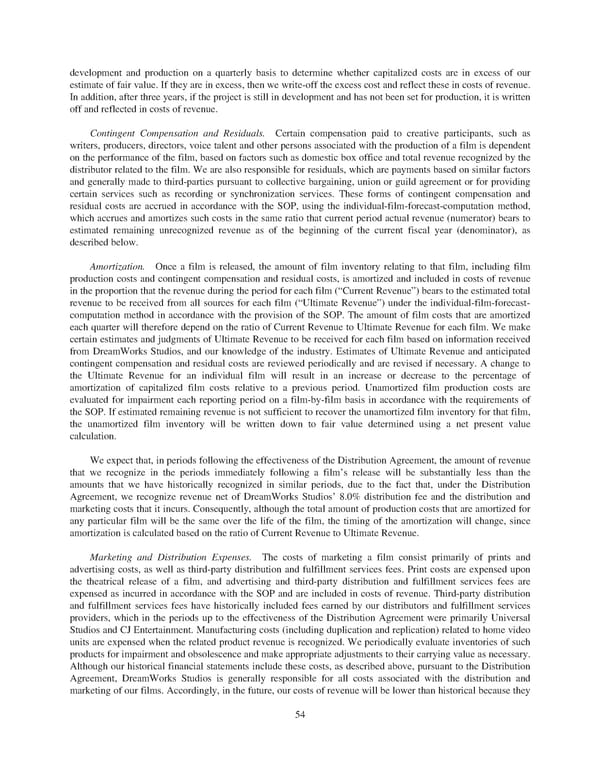development and production on a quarterly basis to determine whether capitalized costs are in excess of our estimate of fair value. If they are in excess, then we write-off the excess cost and reflect these in costs of revenue. In addition, after three years, if the project is still in development and has not been set for production, it is written off and reflected in costs of revenue. Contingent Compensation and Residuals. Certain compensation paid to creative participants, such as writers, producers, directors, voice talent and other persons associated with the production of a film is dependent on the performance of the film, based on factors such as domestic box office and total revenue recognized by the distributor related to the film. We are also responsible for residuals, which are payments based on similar factors and generally made to third-parties pursuant to collective bargaining, union or guild agreement or for providing certain services such as recording or synchronization services. These forms of contingent compensation and residual costs are accrued in accordance with the SOP, using the individual-film-forecast-computation method, which accrues and amortizes such costs in the same ratio that current period actual revenue (numerator) bears to estimated remaining unrecognized revenue as of the beginning of the current fiscal year (denominator), as described below. Amortization. Once a film is released, the amount of film inventory relating to that film, including film production costs and contingent compensation and residual costs, is amortized and included in costs of revenue in the proportion that the revenue during the period for each film (“Current Revenue”) bears to the estimated total revenue to be received from all sources for each film (“Ultimate Revenue”) under the individual-film-forecast- computation method in accordance with the provision of the SOP. The amount of film costs that are amortized each quarter will therefore depend on the ratio of Current Revenue to Ultimate Revenue for each film. We make certain estimates and judgments of Ultimate Revenue to be received for each film based on information received from DreamWorks Studios, and our knowledge of the industry. Estimates of Ultimate Revenue and anticipated contingent compensation and residual costs are reviewed periodically and are revised if necessary. A change to the Ultimate Revenue for an individual film will result in an increase or decrease to the percentage of amortization of capitalized film costs relative to a previous period. Unamortized film production costs are evaluated for impairment each reporting period on a film-by-film basis in accordance with the requirements of the SOP. If estimated remaining revenue is not sufficient to recover the unamortized film inventory for that film, the unamortized film inventory will be written down to fair value determined using a net present value calculation. Weexpect that, in periods following the effectiveness of the Distribution Agreement, the amount of revenue that we recognize in the periods immediately following a film’s release will be substantially less than the amounts that we have historically recognized in similar periods, due to the fact that, under the Distribution Agreement, we recognize revenue net of DreamWorks Studios’ 8.0% distribution fee and the distribution and marketing costs that it incurs. Consequently, although the total amount of production costs that are amortized for any particular film will be the same over the life of the film, the timing of the amortization will change, since amortization is calculated based on the ratio of Current Revenue to Ultimate Revenue. Marketing and Distribution Expenses. The costs of marketing a film consist primarily of prints and advertising costs, as well as third-party distribution and fulfillment services fees. Print costs are expensed upon the theatrical release of a film, and advertising and third-party distribution and fulfillment services fees are expensed as incurred in accordance with the SOP and are included in costs of revenue. Third-party distribution and fulfillment services fees have historically included fees earned by our distributors and fulfillment services providers, which in the periods up to the effectiveness of the Distribution Agreement were primarily Universal Studios and CJ Entertainment. Manufacturing costs (including duplication and replication) related to home video units are expensed when the related product revenue is recognized. We periodically evaluate inventories of such products for impairment and obsolescence and make appropriate adjustments to their carrying value as necessary. Although our historical financial statements include these costs, as described above, pursuant to the Distribution Agreement, DreamWorks Studios is generally responsible for all costs associated with the distribution and marketing of our films. Accordingly, in the future, our costs of revenue will be lower than historical because they 54
 DreamWorks Annual Report Page 59 Page 61
DreamWorks Annual Report Page 59 Page 61